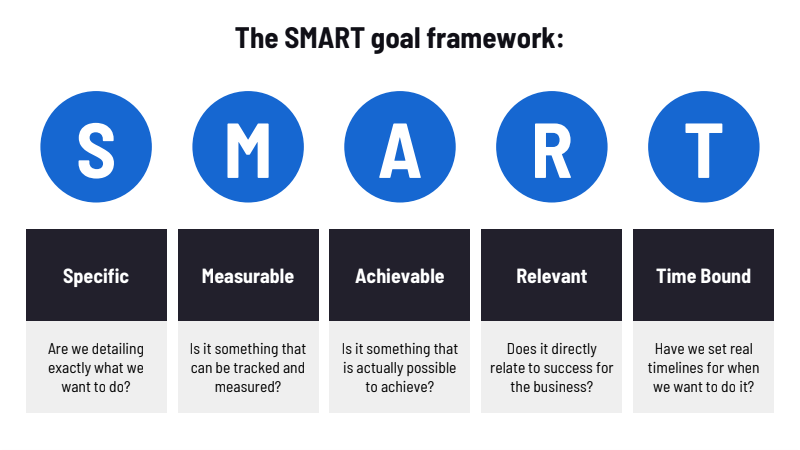Article's Content
It’s a new year, and you know what that means…
Time to set some goals! Specifically—marketing goals.
But this is not your average post with five cookie-cutter goals that may not even fit your brand’s vision.
This is an action-oriented, research-backed post that will help you set your team up for success in all your B2B marketing efforts in the year ahead.
The only way to fail: Read this post and do nothing.

Goals only work if you do, so if you don’t put in the time and energy to see these recommendations through, then your shortfalls can only be blamed on your complacency.
Sorry to be so blunt, but the insights in this post come from leaders in the business, and I’ve broken them down with examples and templates just for you. Couldn’t be easier.
So do you want to lie back and kick your feet up, or get to work and make some magic happen?
…that’s what I thought.
Let’s get to it.
Why Should You Set Marketing Goals for Your Business?
Goals are important for growth.
This is true for business growth, individual growth, economic growth, etc.
What goals offer is direction—a roadmap, of sorts, toward better results.
You know when you book a trip for a couple months down the road, and then all of a sudden you start your mornings with a pip in your step?

It’s because you have something to look forward to. Your days have purpose. Each day gets you one step closer to the beach, the sun, relaxation…
Goals work the same way: Reaching that end goal is like making it to that tropical getaway. And in the meantime, having a plan for where you want to be on X date increases your motivation because you can visualize the results of your efforts.
The key to setting goals effectively is to not just set ’em and forget ’em.

Thinking about your goals, visualizing them, and even saying them out loud is great, but it’s when you write them down and make a marketing plan that you can truly start to see the needle move. In fact, research has proven that those who write down their goals are much more successful in achieving them.
I’ll talk more about how you can go about documenting your goals and making plans to accomplish them in the sections below.
What Are Your Company’s Business Goals?
Before we dive into setting your marketing goals, let’s ensure you’ve got your house in order regarding overall company goals and objectives.
If you’re running your marketing department and don’t know what your company’s business goals are, stop what you’re doing and find those out before going any further.
As important as marketing goals are, they must relate back to your company’s overall goals. For example, for those in the software sector, understanding and integrating a SaaS marketing plan is essential to ensure alignment with broader business objectives. Any one team or department will only succeed if there’s alignment throughout the organization.
Company goals are often sales-related—more customers, more revenue, more profit…
For example, let’s say your company has a goal of increasing revenue. Now let’s say your marketing team has a goal of increasing organic blog traffic.
Hate to break it to ya, but traffic doesn’t pay the bills—at least not directly! So how do we get there?
Well, more traffic could lead to more user signups.
More user signups could lead to more demo requests.
More demo requests could lead to more sales.
And that translates to more revenue! 💲💲💲

So that marketing goal is actually in alignment with the company’s goals.
The point is, your goals must be intentional. Figure out what marketing activities will bring the most value to your company, and put your energy into those.
Let’s look at how you might craft a well-defined marketing goal based on your business goals:
Let’s say your company is looking to generate $80K for the month. How can you use this number to form a relevant marketing goal?
Well, you know that one sale brings in $15K. And maybe you know that for your sales team to close one sale, they typically have to comb through about 10 prospects. Maybe you also know that out of the last 50 qualified leads you brought in, 10 prospects were sourced.
That means to reach at least $80K, you need six new sales, which means sourcing 60 prospects, which means generating 300 qualified leads.
So now you know you need to bring in enough website traffic (X) to capture 300 new leads:

You may not know what X is, and that’s OK! Pinpointing the right number may take some trial and error, but at least you’ve got a starting point. Halfway through the month you can reevaluate to see if you’re on track based on how many leads you’ve captured, or whether you need to ramp things up.
If you work backwards from every goal in a similar fashion, you can find marketing <> company alignment, no problem.
One more word on marketing and sales…
Sales and marketing are two teams long said to have been at odds. Marketing has their idea of what a qualified lead is and sales has another. Luckily, we see this trend changing for the better.
Do yourself, and everyone, a favour by discussing your expectations early on. For this discussion to go smoothly, you’ll need to have a strong understanding of your target audience and who is most likely to buy. From there you can list out your criteria for a qualified lead—this could be based on how much they make, how many employees they have, what their budget is, etc.
Collaborate to find common ground, and then, you, the marketer, need to go away and work harder to generate leads based on the criteria you’ve agreed upon. Opt-in forms work great for weeding out prospects by tailoring questions and inputs to your qualifications (a drop-down menu selection would work well for displaying these types of filtering questions).
Other tips for keeping the peace: Communicate frequently, track your results, and be open to making adjustments along the way.
How To Set SMART Goals
Not only do you want your marketing goals to align with your company goals, but you also want to make sure your goals are SMART. Here’s what I mean by that:

With these components in mind, you can begin to formulate some marketing goals of your own.
Here are some examples of SMART marketing goals that may make sense for your organization:
I want to:
- Increase organic traffic by 15% MoM
- Boost landing page conversions by 20% per month by year-end
- Generate 400 MQLs per month by April
- Improve X (formerly known as Twitter) engagement (qualitative)
For your own SMART goal-setting template to work with, click here:
Now, thinking back to the previous section, these SMART marketing goals have to align with the company’s goals. We already determined that increasing organic traffic aligns with the goal of increasing revenue, but what about the others?
Well, improving landing page conversions results in more leads, which lowers the cost per acquisition (CPA).
More MQLs means more sales qualified leads. This leads to bigger pipelines and, if your close rate is consistent, more closed deals.
Better engagement means improved customer satisfaction, which leads to better retention.
As you can see, all of the above SMART marketing goals translate into common sales goals. Be prepared to back yours up the same way.
How To See Your Goals Through To Completion
You may have heard this well-known quote: “A goal without a plan is just a wish.”
It’s well-known for a reason.
Trying to achieve your goals without a plan is a bit like navigating a grocery store without a list. You might pick up everything you were supposed to, but more likely you’ll miss a few important things and end up with some impulse buys you don’t actually need.
When you set out to complete a goal, you want to clearly define your path for doing so.
This is where OKRs come in.
OKRs are objectives and key results, and they provide a formula for executing goals.
Originated by Andy Grove, president of Intel, and made popular by one of his former employees, John Doerr, OKRs streamline goal-setting by creating company objectives that translate into individual objectives, and making these transparent company-wide.
Your objectives tell you what you’re working toward, and key results show you how you’ll get there.
The key results that drive company objectives become individual objectives for each team member. And then each team member has key results to drive their individual objectives.
Several team members could be contributing to the same individual objective in an effort to more efficiently move the needle on the larger company objective.

I don’t blame you if you’re confused! Let’s break this down:
Your company may have a high-level objective, like “Increase Annual Profits.”
Company Objective: Increase Annual Profits
Then you might identify 3–5 key results to help achieve this objective.
Key Results: Increase Annual Revenue in Division X
Improve Company Close Rate
Optimize Product A
These key results are then divvied up amongst your team as individual objectives, and associated with their own key results:
Individual Objective: Increase Annual Revenue in Division X
Key Results: Launch 2 New Products by Q3
Start Selling in 2 New Markets
Increase Quarterly Revenue to $250,000
Got it?
Here’s a template you can use to start mapping your own OKRs:
For more on OKRs, watch and listen as Doerr talks about his experience and lessons working under Andy Grove, in this TED Talk.
It doesn’t matter what you know, it’s execution that matters the most. —Andy Grove
Now, OKRs don’t guarantee success, but if you fall short, it won’t be due to a lack of strategy.
And keep in mind, OKRs are supposed to be ambitious. Make them SMART, but don’t make them easy.
Don’t Forget A Proactive Dashboard!
To track your OKR progress at a more granular level, you can use a proactive dashboard. This tool is a separate team-wide tracker, and anything recorded within it is fully dependent on the person it is assigned to.
All the activities listed are ones you can control.
So pick a goal from one of your key results and map out what marketing activities will help get you there—but only those that you can make happen with direct action. For example:
Individual Objective: Launch 2 New Products by Q3
Proactive Dashboard Activities:
Run a Market Analysis To Determine Product-Market Fit
Conduct Customer Research With Current Customers
Hold Internal Brainstorming Session With Product Team
The key is to monitor your progress as you go and to make adjustments by adding or removing items along the way. If you find that an activity is not making any impact toward the objective, experiment with something new.
So to repeat, the three steps for making and monitoring your proactive dashboard are:
- Define your objective
- Map your activities
- Revise your approach
Here’s Noah Kagan of Sumo Group—the guy who brought the proactive dashboard to the mainstream—describing how it works in more detail:
Wrapping Things Up
Goal setting for the month or year ahead can take significant time, but it’s an investment you’ll thank yourself for later.
If you’re serious about seeing better marketing results and overall company growth, don’t rush through it. Charge someone on your team with facilitating the development of goals, OKRs, and a proactive dashboard, and disseminate your strategy company-wide to promote transparency and accountability.
Ready to take the new decade by storm? Once you have your goals in place for the new year, take your planning up a notch with a detailed and customized B2B content marketing strategy.
Let’s make 2025 count!










